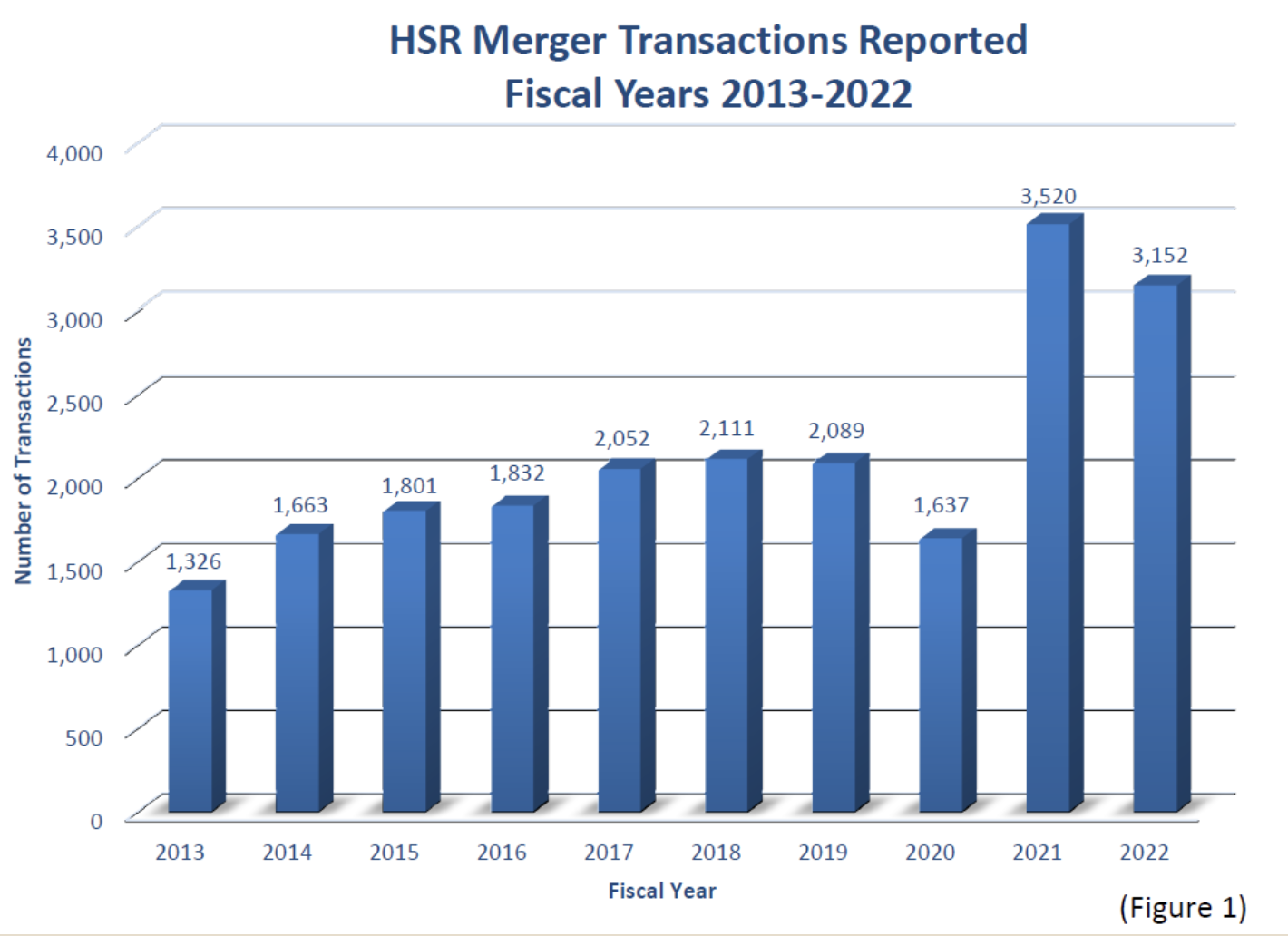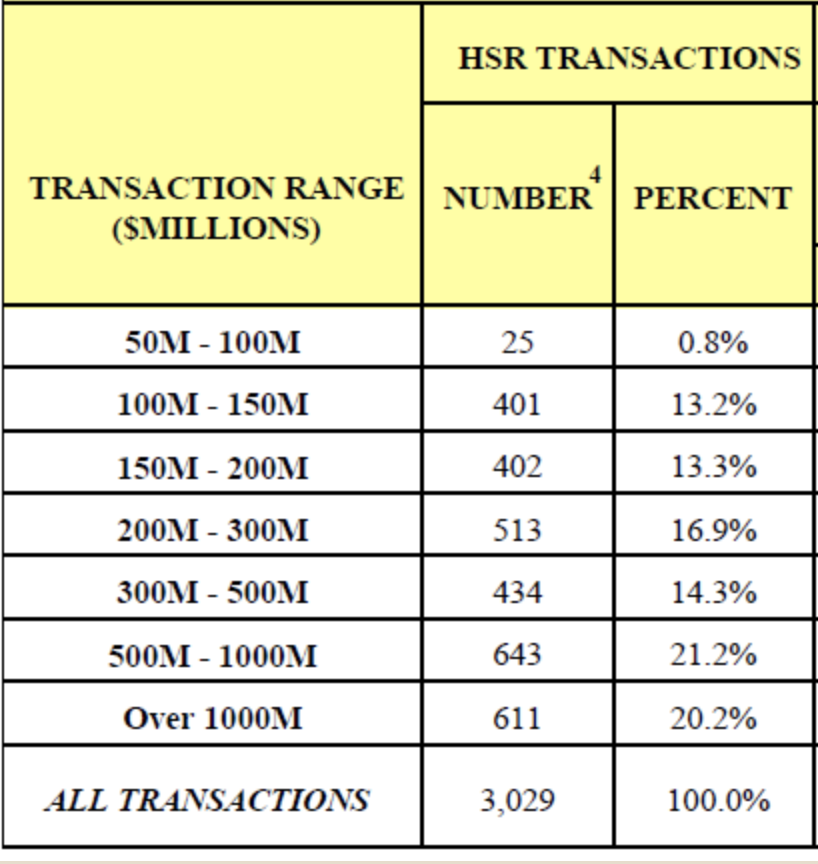Comments
- No comments found

2021 and 2022 witnessed a notable surge in corporate mergers across various industries.
The Hart-Scott-Rodino Antitrust Improvements Act of 1976 requires that all mergers above a certain size–now $101 million–must be reported to the federal government before they occur.
This gives the authorities at the Federal Trade Commission and the Antitrust Division at the US Department of Justice a chance to challenge mergers, if and when warranted. The law also requires an annual report on the state of antitrust enforcement, and the report for fiscal 2022 has just been published.
One part of each annual report just provides a count of the mergers that were reported, the size of the mergers, and how many were challenged. Here’s a figure from the Hart-Scott-Rodino Annual Report Fiscal Year 2022, showing the boom in mergers in 2021 and 2022.

Here’s the size distribution of the reported transactions: 611 of the deals were more than $1 billion and another 643 were between $500 million and $1 billion. (The total here differs slightly from the figure above, because in a few cases, both parties to a merger file a report, and the double-reported mergers are not included in this table.)

Of the 3,152 reported to the antitrust authorities in 2022, how many were challenged? Given the tone of arguments about antitrust, you might assume the number is pretty high. But as the report notes:
During fiscal year 2022, the Commission brought 24 merger enforcement challenges: eleven in which it issued final consent orders after a public comment period; seven in which the transaction was abandoned or restructured as a result of antitrust concerns raised during the investigation; and six in which the Commission initiated administrative or federal court litigation. The 24 merger enforcement challenges the Commission brought in fiscal year 2022 is the second highest figure in the last ten years.
This relatively low number seems reasonable to me, in the sense that companies proposing a merger know that the antitrust authorities will be taking a look, and so become less likely to proposed egregiously anticompetitive mergers. Also, the job of the antitrust regulators is not to second-guess whether a proposed merger is a wise business decision, but only whether it will have anti-competitive effects.
Each year, the report also does a bit of gentle bragging about the cases it has won–either in court, or as part of a consent decree (that is, the firms agreed to certain changes or to selling off certain parts of the firm before the merger), or because a merger was dropped when it was challenged. For example:
In January 2022, the Commission issued an administrative complaint and a authorized staff to seek a preliminary injunction to prevent Lockheed Martin’s proposed acquisition of Aerojet. The complaint alleged that this proposed vertical merger would likely allow Lockheed to harm rival defense contractors by cutting them off from Aerojet’s critical components needed to build competing missiles. Shortly after the Commission filed its complaint, the parties abandoned the transaction. This lawsuit represented the first time in decades that the Commission had sought to outright block a defense industry transaction.
In February 2022, the two largest healthcare systems in Rhode Island, Lifespan and Care New England Health System, called off their merger after the FTC, in conjunction with the Rhode Island Attorney General, sought to block the merger. On the same day in June 2022, the Commission voted to block two proposed hospital mergers: HCA’s acquisition of Steward Health Care System and RWJBarnabas’s acquisition of Saint Peter’s Healthcare System. Both of these acquisitions were later abandoned. The Commission will continue to identify and aggressively challenge hospital mergers that threaten access to critical healthcare services. …
One of the Division’s most notable successes was its efforts to block Penguin Random House’s proposed purchase of a major publishing rival, Simon & Schuster. The merger, if completed, would have eliminated competition that had led to higher advances, better services, and more favorable contract terms for authors trying to sell their work. The merger also jeopardized the breadth, depth, and diversity of written work by authors. The Division filed suit to block the merger in November 2021; after a thirteen-day trial in August 2022, the U.S. District Court for the District of Columbia found that the proposed acquisition violated Section 7 of the Clayton Act based on the harm it would cause to a specific class of workers in this case, authors.
The government antitrust authorities at the US Department of Justice and the Federal Trade Commission have also just released the final version of the Merger Guidelines. As the website notes, the Guidelines are “describe factors and frameworks the Agencies often utilize when reviewing mergers and acquisitions,” and “are a non-binding statement that provides transparency on aspects of the deliberations the Agencies undertake in individual cases under the antitrust laws.” The draft version of the guidelines released last summer engendered considerable controversy, as I noted here, here, and here. Between the ongoing wave of merger activity and the more pugilant stance of the current antitrust authorities as expressed in the guidelines, antitrust topics are going to make some news in 2024.
Timothy Taylor is an American economist. He is managing editor of the Journal of Economic Perspectives, a quarterly academic journal produced at Macalester College and published by the American Economic Association. Taylor received his Bachelor of Arts degree from Haverford College and a master's degree in economics from Stanford University. At Stanford, he was winner of the award for excellent teaching in a large class (more than 30 students) given by the Associated Students of Stanford University. At Minnesota, he was named a Distinguished Lecturer by the Department of Economics and voted Teacher of the Year by the master's degree students at the Hubert H. Humphrey Institute of Public Affairs. Taylor has been a guest speaker for groups of teachers of high school economics, visiting diplomats from eastern Europe, talk-radio shows, and community groups. From 1989 to 1997, Professor Taylor wrote an economics opinion column for the San Jose Mercury-News. He has published multiple lectures on economics through The Teaching Company. With Rudolph Penner and Isabel Sawhill, he is co-author of Updating America's Social Contract (2000), whose first chapter provided an early radical centrist perspective, "An Agenda for the Radical Middle". Taylor is also the author of The Instant Economist: Everything You Need to Know About How the Economy Works, published by the Penguin Group in 2012. The fourth edition of Taylor's Principles of Economics textbook was published by Textbook Media in 2017.
Leave your comments
Post comment as a guest